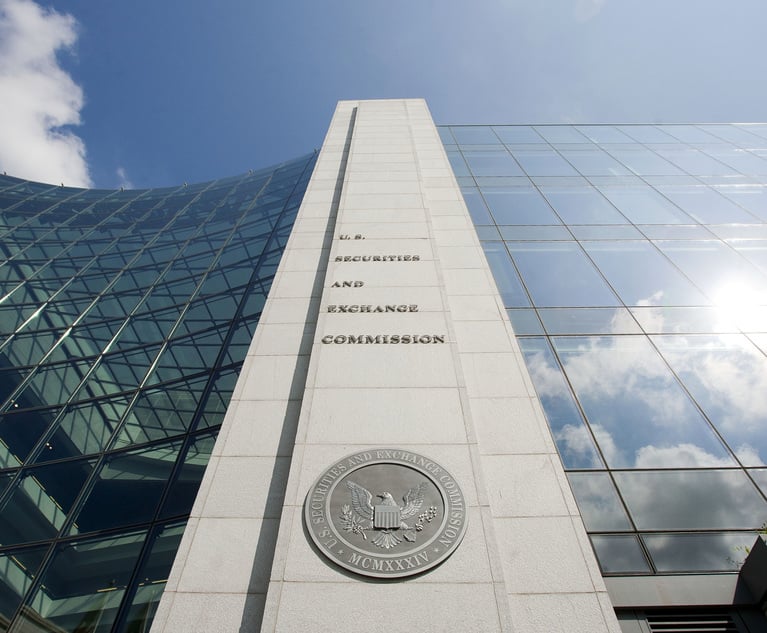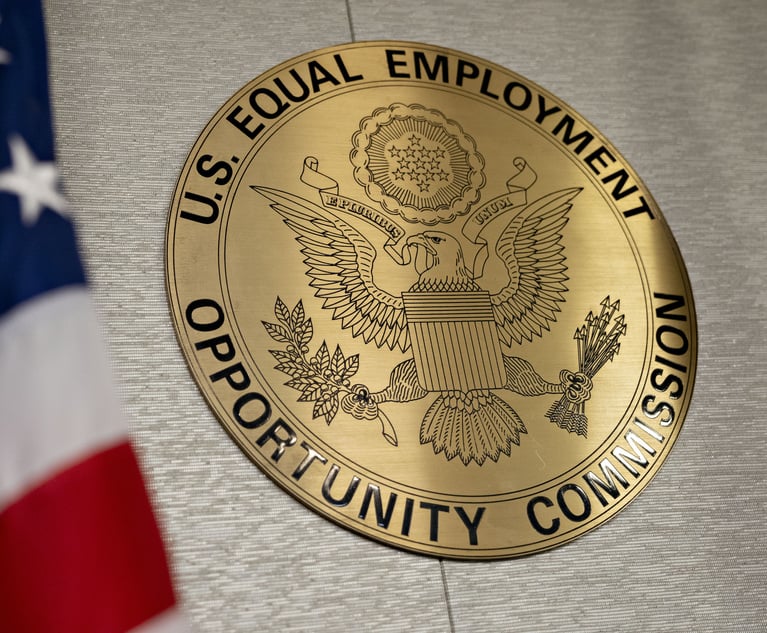Litigation: Is knowing a reporter’s confidential source knowing too much?
During last weeks pilot episode of HBOs new series The Newsroom, star cable news anchor Will McAvoy came face-to-face with a scoop on one of the biggest news stories in recent memory.
July 05, 2012 at 07:02 AM
7 minute read
The original version of this story was published on Law.com
During last week's pilot episode of HBO's new series “The Newsroom,” star cable news anchor Will McAvoy came face-to-face with a scoop on one of the biggest news stories in recent memory: According to sources unearthed by McAvoy's brand new senior producer, what appeared to be a run-of-the-mill explosion on an oil rig off the Gulf Coast was actually the beginning of the 2010 Deepwater Horizon oil spill—and was likely not a freak accident, but could be blamed on private industry and lax enforcement of federal regulations. The problem? All of the producer's sources were confidential. McAvoy thereby found himself in a position all too familiar to editors across the country: Should he rely on his reporter, or did he himself need to know the identities of the sources (who ostensibly had been promised that their names would never be revealed to anyone)?
McAvoy's dilemma recently played out in the real world at the Detroit Free Press. In a decision issued just three days before “The Newsroom”'s premier, in Convertino v. United States Dep't of Justice, No. 11-5133, the D. C. Circuit charted the perilous legal landscape that reporters, editors and litigants must navigate when civil discovery intersects with a reporter's promise to protect anonymous whistleblowers.
Plaintiff Richard G. Convertino, a former Assistant U.S. Attorney in Michigan, had the distinction of prosecuting the first terrorism trial after the Sept. 11 attacks. In June 2003, Convertino won convictions against individuals charged with being members of a Detroit-based sleeper cell of an international terrorist organization. Convertino's victory, however, was short-lived.
Later that fall, he was removed from the case based on allegations that he had committed ethical violations—withholding exculpatory and impeachment evidence in violation of Brady v. Maryland, 373 U.S. 83 (1963) and Giglio v. United States, 405 U.S. 150 (1972) —during the prosecution. This misconduct ultimately led not only to the convictions being vacated, but also to Convertino being investigated by the Department of Justice's (DOJ) Office of Professional Responsibility (OPR).
News of Convertino's OPR referral soon found its way into the hands of a reporter who, on Jan. 17, 2004, published a front-page article in the Detroit Free Press entitled “Terror Case Prosecutor is Probed on Conduct.” The article, like “The Newsroom”'s Deepwater Horizon scoop, was based on details attributed to “department officials” “who spoke on condition of anonymity, fearing repercussions.”
Convertino, who ultimately was acquitted of the charges against him, sued the Attorney General and other DOJ employees in federal court in the District of Columbia for violation of the Privacy Act, 5 U.S.C. §§ 552a et seq., to recover damages for the leak. To prove his case, Convertino needed to show that the leak was made willfully. He subpoenaed the reporter and the Free Press in an effort to identify the leaker. A federal judge in Michigan, where the depositions were to take place, ordered the reporter to testify. The judge also held in abeyance the deposition of the newspaper unless and until Convertino was unable to identify the leaker through the reporter's deposition. During his deposition, the reporter asserted his Fifth Amendment privilege against self-incrimination to avoid identifying his source. The Michigan judge later approved of the assertion of this privilege, and thus Convertino came back from the reporter's deposition empty-handed.
In the meantime, back in D.C., the DOJ filed a motion for summary judgment. It argued that Convertino's claim must fail because it was unlikely that he would ever succeed in his quest to identify the leaker. Convertino cross-moved under Rule 56(f) to pursue discovery from the newspaper, but the district court found that these efforts would be futile and granted summary judgment to the DOJ.
The Court of Appeals reversed. It found that Rule 56(f) motions should be granted where the movant identifies specific discovery, yet to be taken, that is relevant and discoverable. The court found that Convertino met that standard because he might still be able to obtain the information from the newspaper. The court reasoned that the newspaper, as a corporation, could not claim any protection under the Fifth Amendment, which only applies to natural persons.
And although the newspaper represented that the reporter was the only person on staff with knowledge of the article's confidential sourcing, the court found that there was a more than speculative basis to infer that this may not be true: A privilege log produced by the reporter suggested that at least one other individual at the paper could know the identity of the source. The newspaper had access to the reporter's documents because they were created within the scope of his employment, and the newspaper conceded that it publishes articles based on confidential sources only where they are approved by the “highest-ranking editor available.”
The decision provides insight into how badly things can go when issues involving confidential sources are litigated. The reporter's decision to invoke the Fifth Amendment privilege against self-incrimination, while an effective measure to avoid contempt sanctions, raises the specter that reporters may be held liable for obtaining leaked information. Setting such a precedent seems risky for a person whose profession is gathering news. It also runs counter to the logic in the Supreme Court's ruling in Bartnicki v. Vopper, 532 U.S. 514 (2001), which held that the First Amendment protects speech that discloses the contents of illegally obtained information so long as the speaker did not himself violate the law.
Convertino's crusade also teaches publishers and editors a few lessons about whether it is really worth it to know the identity of confidential sources. The Free Press, after all, can only testify about what it knows, and if the reporter never gives up his source to anyone at the publication, it is unlikely that the company could be held responsible. Of course, any newsroom with a tip about misfeasance will need to vet the sourcing in order to evaluate the risk of publishing.
Convertino counsels that the better practice for such vetting may be for the publisher to learn about the source's credentials and reputation for reliability, rather than learning the source's name. Asking how the source knows the information, whether the source has been reliable in the past, whether anything the source has ever said has proven to be untrue and whether the reporter has been able to corroborate the source's information for the present story or for past stories often provides sufficient information to evaluate the legal risk in publishing a story without need for the reporter to reveal the source.
In “The Newsroom,” McAvoy took another course. Despite the senior producer's pleas that he should be taken on his word that the sources were reliable, McAvoy gave an ultimatum: tell me who the sources are, or there is no story. Convertino teaches that, in the real world, McAvoy may have come to regret that decision. Although it seems unlikely that a cable drama about a newsroom would use future episodes to delve into such legal issues, if “The Newsroom” ever decided to go that route, a courtroom dilemma caused by McAvoy's uncovering the cause of the greatest environmental disaster in human history might just lead to another real-life news story: the unleashing of public support for a federal reporters' privilege that protects confidential sources and the journalists who rely on them.
This content has been archived. It is available through our partners, LexisNexis® and Bloomberg Law.
To view this content, please continue to their sites.
Not a Lexis Subscriber?
Subscribe Now
Not a Bloomberg Law Subscriber?
Subscribe Now
NOT FOR REPRINT
© 2025 ALM Global, LLC, All Rights Reserved. Request academic re-use from www.copyright.com. All other uses, submit a request to [email protected]. For more information visit Asset & Logo Licensing.
You Might Like
View All

Trending Stories
- 1Uber Files RICO Suit Against Plaintiff-Side Firms Alleging Fraudulent Injury Claims
- 2The Law Firm Disrupted: Scrutinizing the Elephant More Than the Mouse
- 3Inherent Diminished Value Damages Unavailable to 3rd-Party Claimants, Court Says
- 4Pa. Defense Firm Sued by Client Over Ex-Eagles Player's $43.5M Med Mal Win
- 5Losses Mount at Morris Manning, but Departing Ex-Chair Stays Bullish About His Old Firm's Future
Who Got The Work
J. Brugh Lower of Gibbons has entered an appearance for industrial equipment supplier Devco Corporation in a pending trademark infringement lawsuit. The suit, accusing the defendant of selling knock-off Graco products, was filed Dec. 18 in New Jersey District Court by Rivkin Radler on behalf of Graco Inc. and Graco Minnesota. The case, assigned to U.S. District Judge Zahid N. Quraishi, is 3:24-cv-11294, Graco Inc. et al v. Devco Corporation.
Who Got The Work
Rebecca Maller-Stein and Kent A. Yalowitz of Arnold & Porter Kaye Scholer have entered their appearances for Hanaco Venture Capital and its executives, Lior Prosor and David Frankel, in a pending securities lawsuit. The action, filed on Dec. 24 in New York Southern District Court by Zell, Aron & Co. on behalf of Goldeneye Advisors, accuses the defendants of negligently and fraudulently managing the plaintiff's $1 million investment. The case, assigned to U.S. District Judge Vernon S. Broderick, is 1:24-cv-09918, Goldeneye Advisors, LLC v. Hanaco Venture Capital, Ltd. et al.
Who Got The Work
Attorneys from A&O Shearman has stepped in as defense counsel for Toronto-Dominion Bank and other defendants in a pending securities class action. The suit, filed Dec. 11 in New York Southern District Court by Bleichmar Fonti & Auld, accuses the defendants of concealing the bank's 'pervasive' deficiencies in regards to its compliance with the Bank Secrecy Act and the quality of its anti-money laundering controls. The case, assigned to U.S. District Judge Arun Subramanian, is 1:24-cv-09445, Gonzalez v. The Toronto-Dominion Bank et al.
Who Got The Work
Crown Castle International, a Pennsylvania company providing shared communications infrastructure, has turned to Luke D. Wolf of Gordon Rees Scully Mansukhani to fend off a pending breach-of-contract lawsuit. The court action, filed Nov. 25 in Michigan Eastern District Court by Hooper Hathaway PC on behalf of The Town Residences LLC, accuses Crown Castle of failing to transfer approximately $30,000 in utility payments from T-Mobile in breach of a roof-top lease and assignment agreement. The case, assigned to U.S. District Judge Susan K. Declercq, is 2:24-cv-13131, The Town Residences LLC v. T-Mobile US, Inc. et al.
Who Got The Work
Wilfred P. Coronato and Daniel M. Schwartz of McCarter & English have stepped in as defense counsel to Electrolux Home Products Inc. in a pending product liability lawsuit. The court action, filed Nov. 26 in New York Eastern District Court by Poulos Lopiccolo PC and Nagel Rice LLP on behalf of David Stern, alleges that the defendant's refrigerators’ drawers and shelving repeatedly break and fall apart within months after purchase. The case, assigned to U.S. District Judge Joan M. Azrack, is 2:24-cv-08204, Stern v. Electrolux Home Products, Inc.
Featured Firms
Law Offices of Gary Martin Hays & Associates, P.C.
(470) 294-1674
Law Offices of Mark E. Salomone
(857) 444-6468
Smith & Hassler
(713) 739-1250







